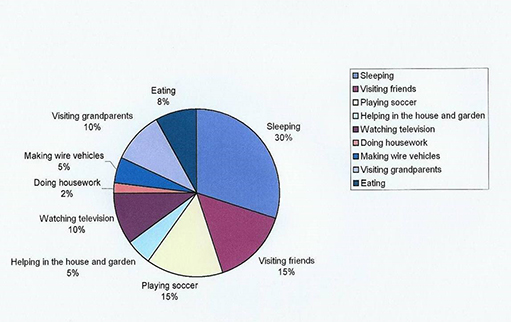Resource 4: A pie chart
![]() Teacher resource for planning or adapting to use with pupils
Teacher resource for planning or adapting to use with pupils
a) A pie chart: How Iredia spends his time at weekends

Basic information
30% sleeping;
15% visiting friends;
15% playing soccer;
5% helping in the house and garden;
10% watching television;
2% doing homework;
5% making wire vehicles;
10% visiting grandparents;
8% eating.
b) Questions on the pie chart
- What does the pie chart tell us? (How Iredia spends his time at weekends.)
- What does Iredia spend the most time doing? (Sleeping.)
- What does he spend the least time doing? (Homework.)
- What does he do for the same amount of time as he watches television? (Visits grandparents.)
- What does he do for the same amount of time as helping in the house and garden? (Making wire vehicles.)
- When he is awake, what two things does Iredia spend the most time doing? (Visiting friends and playing soccer.)
- If you made a pie chart to show how you spend your weekend, would it be similar to Iredia’s or different? (Many possible answers.)
- You could help pupils write about their partner’s weekend by designing a writing frame with them, or by agreeing an example paragraph together. Here are examples for use to use or adapt.
Writing frame for describing a partner’s weekend X’s weekends X likes/doesn’t like weekends… He/she spends the greatest part of the weekend… He/she usually… and sometimes… On Saturday mornings… On Saturday afternoons… On Saturday evenings… On Sunday mornings… On Sunday afternoons… On Sunday evenings… |
c) Paragraph about Iredia’s weekends
Iredia loves weekends. He enjoys staying in his warm bed much later than on school mornings and taking his time over meals with the family. He spends the biggest part of his weekend visiting friends and playing soccer. He usually watches television with his family in the evenings and sometimes stays up very late to do this. On Saturday mornings he and his sisters help their parents with cleaning the house or working in the garden. After they have finished, his sisters like to go to the shops but Iredia either goes to his friends or spends some time making wire cars and trucks that he and his friends can race. Sometimes he takes his cars and trucks to show his grandparents when he visits them on Sundays. Usually he needs to find some time on Sunday evening to do his homework for Monday.
Some of the information in this paragraph cannot be gleaned from the chart. The author has made up bits based on their experience and the data given. You may wish to explore this with your pupils. Ask them what they can say from the chart and which parts are made up.
d) What you and your pupils can learn from these activities
- To read information on a pie chart.
- To compare one item of information on the chart with another.
- To make a pie chart in order to summarise information.
- To understand that the same information can be presented in different ways.
- To use information from a pie chart to write a paragraph.
- To learn ‘time expressions’ (e.g. ‘usually’, ‘sometimes’).
e) Ideas for further activities
To consolidate pupils’ learning about pie charts, they could make another one – perhaps about class birthdays or about sports teams they support or languages they speak. You could also decide to show them other ways of representing information such as a bar graph or a table if you have information about these. Your colleagues may be able to assist you here.
Resource 3: Good posters



